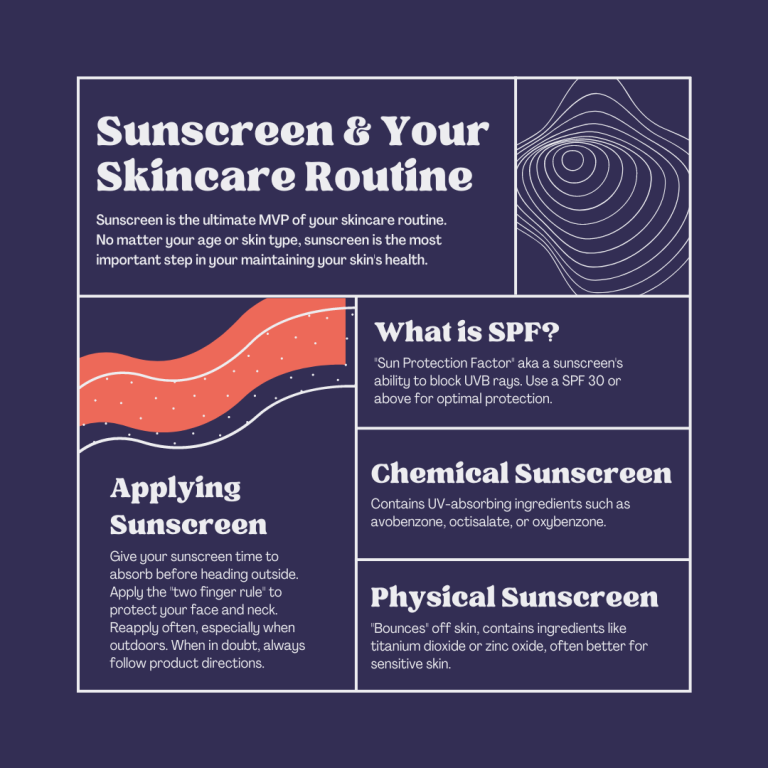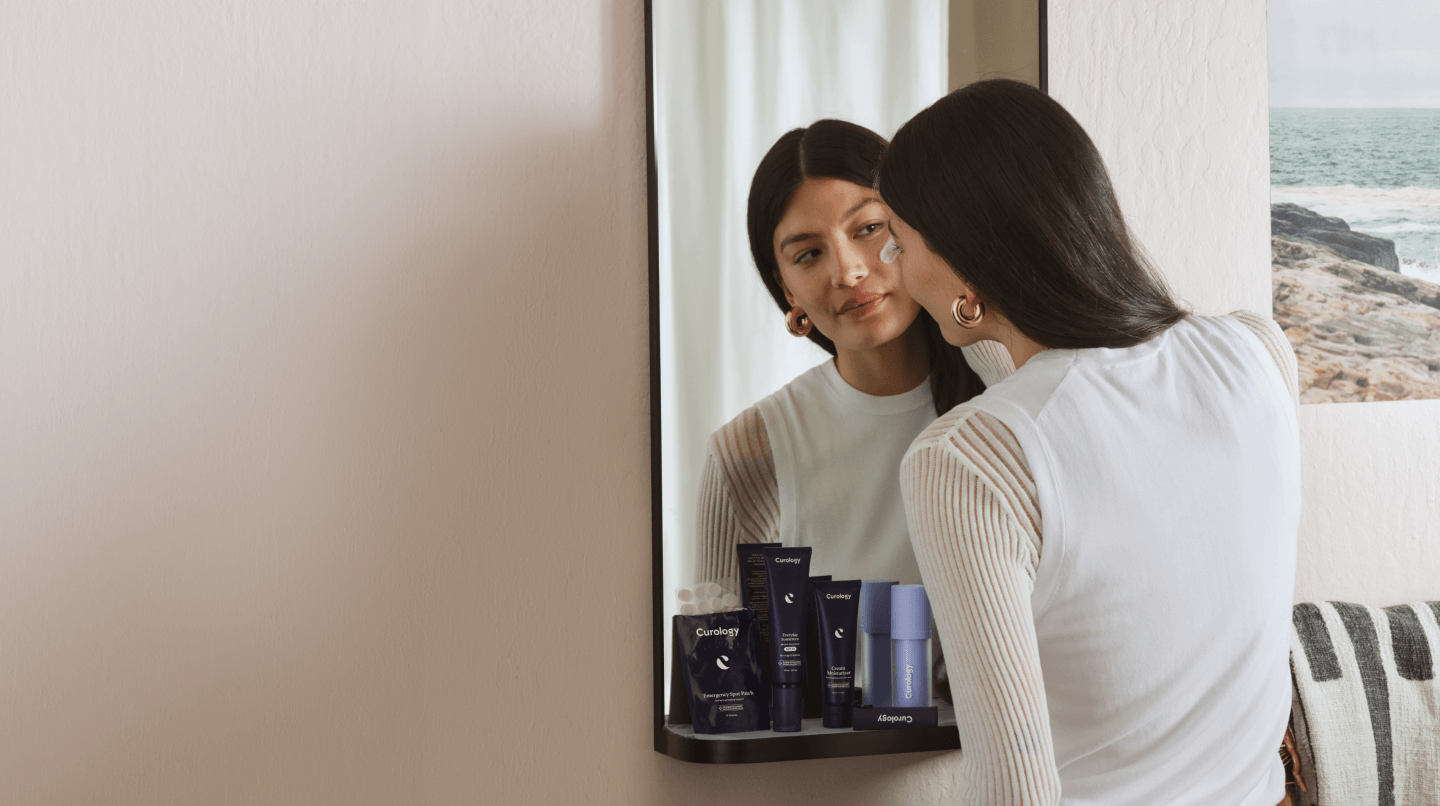How it works:
Share your skin goals and snap selfies
Your dermatology provider prescribes your formula
Apply nightly for happy, healthy skin
How it works:
How it works:
Share your skin goals and snap selfies
Your dermatology provider prescribes your formula
Apply nightly for happy, healthy skin
How it works:
How does sunscreen work? Does it help to prevent wrinkles?
Get the inside scoop on why sunscreen should be your new BFF.



No matter your age or skin type, protecting your skin against sun exposure and ultraviolet (UV) rays is the most important step you can take for the health of your skin. The science behind sunscreen gives some pretty compelling evidence for why the product deserves the hype. According to the Skin Cancer Foundation,¹ sunscreen works with a minimum of SPF 15 to:
Reduce your risk of squamous cell carcinoma—a type of skin cancer—by 40%
Reduce your risk of melanoma—a skin cancer—by 50%
Help prevent premature aging, including wrinkles and age spots
Help prevent painful sunburns, peeling, and blistering skin
Incorporating the right products with SPF into your skincare and makeup routine helps bring out your best skin.* If you're not already an avid sunscreen-wearer, this is a great place to get familiar with SPF and pick the right product for you.
How should you apply sunscreen?
Believe it or not, most people don’t apply enough sunscreen. The American Academy of Dermatology says most people only apply 25–50% of the recommended amount.² Chances are, you should consider doubling the amount you use, though this recommendation will vary from person to person. Here’s how much you need:
Body: about 2 tablespoons (1 oz), or enough to fill a shot glass³
Face: about half a teaspoon
When in doubt, use the two-finger sunscreen hack, blend well, and don’t forget to reapply every two hours when outdoors, or after swimming or sweating. Sunscreen works only if it’s used as directed—that means the right amount and right application and reapplication!
If you rely solely on your makeup for sun protection, you may not get the protection you need because an adequate amount is not applied. It might be easier to just use regular ol’ sunscreen for sun protection. Remember, sunscreen is your body armor to protect your skin from sun damage.
Here are some more tips for applying specific types of sunscreen to your face.
Lotions: Layer up! Sounds simple, but this advice is extra important. Apply sunscreen as the last layer of your skincare routine and remember to reapply every two hours when outdoors.
Sprays: To avoid potentially inhaling sunscreen, spray your sunscreen into your hands, then massage it onto your face (and elsewhere!). It’s typically best to use spray sunscreen in a well-ventilated area (or outdoors). With sprays, you want enough to make your skin glisten.
Sunscreen sticks: Draw the stick across your face until your skin is covered in an even layer. Then, rub it into the skin. You’ll likely need about three to four passes to get the right amount of coverage. If the product seems hard to blend, try applying it on damp (not wet) skin.
Drops: Dispense drops directly on your face and blend with your fingers. Pro tip: don’t dilute with a moisturizer or foundation, which may diminish the sunscreen’s ability to protect your skin.
How much SPF do you really need?
SPF means “sun protection factor.” It’s a number that measures a sunscreen’s ability to prevent UVB rays from causing skin damage. The number is based on testing that measures protection against sunburn or redness on sunscreen-protected skin compared to unprotected skin.⁴ (If you have dry, flaky skin, sunburn could be the cause.) SPF 30 means it would take 30 times longer to burn than if you used no sunscreen at all, provided you apply it as directed.⁵
A higher SPF number (15, 30, 50, etc.) has nothing to do with how long you can be in the sun. SPF relates to the amount of sun protection, not the amount of time you’re protected from the sun. All sunscreens, regardless of the SPF number, need to be reapplied consistently and as directed (more on that in a bit).
In terms of how much SPF you need, we recommend choosing a sunscreen with broad-spectrum protection and an SPF of 30 or higher (and that’s what dermatologists recommend, too!). Broad-spectrum means you’re protected against both UVA rays and UVB rays. For extended outdoor activity, choose a water-resistant, broad-spectrum sunscreen with SPF 30 or higher.
Which is better: chemical or physical sunscreen?
There are two main kinds of sunscreens: chemical and physical (aka mineral). Both work just fine when it comes to protecting against UV radiation. However, people with sensitive skin often prefer physical sunscreens. If your biggest concern is avoiding a white cast, chemical sunscreens might be the way to go. These two types work differently and have different chemical compositions. Here’s the skinny on the difference between the two.
Chemical sunscreen
Contains active ingredients like oxybenzone, avobenzone, homosalate, and octinoxate
Absorbs UV light so that it can’t penetrate the skin
May be irritating for some people
Physical (or mineral) sunscreen
Active ingredients include titanium dioxide and/or zinc oxide
Physically reflects or “bounces” sunlight away from the skin
Certain kinds of physical sunscreen can leave a white cast on the skin (unless rubbed in well, micronized, or tinted)
What type of sunscreen should I use?
Regardless, the best sunscreen is the one you will use again and again. It’s your best defense against premature skin aging. Just make sure it offers broad-spectrum (UVA and UVB) protection and has an SPF of 30 or higher—and don’t forget to reapply!
The kind of sunscreen you use is a matter of personal choice and may vary depending on the area of the body to be protected. Available sunscreen options include lotions, creams, gels, ointments, wax sticks, and sprays. Sprays offer a great alternative for hard-to-reach places like your upper middle back, where lotions or creams give a hydration boost as facial sunscreens.

How do you apply sunscreen with makeup?
In most cases, you can think of sunscreen (both chemical and physical) as the last step of your skincare routine and the first step of your makeup routine.
Apply sunscreen just before your makeup primer and just after your moisturizer. (BTW, if you’re looking for moisturizers for sensitive skin, we’ve got you covered.)
On the hunt for the best under-makeup sunscreen? Look for a lightweight sunscreen that doesn’t leave a white cast with an SPF of at least 30. Chemical sunscreens can work great for a face full of makeup because of their absorbency. Remember, chemical sunscreens soak into the skin, making a smoother, more even surface to apply makeup. You can definitely use physical sunscreens if that’s what you prefer. Just know that these formulas tend to be thicker and less absorbent, so it might be harder to apply makeup on top.
But when applying sunscreen over makeup (i.e., if you're reapplying throughout the day), absorption is not what you want! Not only can it mess up your makeup, but it also has to penetrate all the other products you're wearing to reach your skin. It often helps to choose a physical sunscreen to layer over your products. Want more tips on how makeup and sunscreen can go hand-in-hand? Check out our guide on how to apply sunscreen over makeup.
At Curology, that’s just one of the reasons we created a 100% mineral sunscreen. We know it can be challenging to find a sunscreen that you truly love, that works with your skin type and your existing skincare routine.
How can I avoid getting greasy?
We feel you—some people would rather risk UV damage than intentionally grease up their face. We’re obviously in the pro-sunscreen camp, though. The good news is that you can have the best of both worlds: sun protection and matte skin. If you want to ditch the greasy look, try these tips:
Cleanse. Wash your face with a gentle, hydrating cleanser, such as the Curology cleanser. Designed by our in-house dermatologists, it is non-comedogenic and can be used by all skin types.
Powder. A mattifying powder (like the BareMinerals Mineral Veil Finish Powder) will keep your sunscreen in place and absorb excess shine.
Blot. Blotting sheets can soak up any excess shine. We like NYX Professional Makeup Blotting Papers, but just about any brand should work!
You can also reach for sunscreens labeled non-greasy or oil-free. You’ll also want to make sure your sunscreen of choice doesn’t have pore-clogging or irritating ingredients.
The sunscreen by Curology is grease-free, won’t leave a white cast on your skin, and doesn’t clog your pores. It’s 100% mineral-based with SPF 30—it’s a physical sunscreen. If you’re looking for a chemical sunscreen, give La Roche-Posay Anthelios Ultra Light Fluid Facial Sunscreen SPF 60 a try, or check out our other sunscreen recommendations here.
How long does sunscreen last after being applied?
Here are the two hard-fast rules.⁶
Reapply sunscreen for every two hours you spend in the sun—even if you’re using more than SPF 30. Remember, the numbers don’t mean you can spend more time in the sun without reapplication!
Apply sunscreen after swimming, sweating, or toweling off—even if you used water-resistant sunscreen (which lasts 40 or 80 minutes).
If you’re not going out much, you probably only need to apply sunscreen once daily, especially if you’re wearing protective clothing. But staying inside isn’t always enough sun protection on its own! UVA rays can penetrate ordinary windows, so definitely be sure not to skip your daily dose of SPF. And there’s no harm in reapplying if you like to sprawl out in a sunny indoor spot.
Want more sunscreen recommendations from our team of skincare experts? Find a sun protection guide for every type of skin below:
Get your personalized skincare routine with Curology
Get your personalized skincare routine with Curology


Start your free trial (plus shipping and handling)
Your questions answered
Curology's newest product is 100% mineral-based grease-free sunscreen that won’t leave a white cast on your skin or clog your pores. Developed and tested by dermatologists, Curology’s sunscreen was formulated specifically with acne-prone skin in mind. The broad-spectrum sunscreen uses zinc oxide to block UV rays and protect you from sun exposure. The SPF 30 sunscreen is formulated to work synergistically with Curology products and can be used daily as part of your skincare routine.
It’s available through a Curology subscription only. For new members, sign up for a 30-day trial and add the sunscreen to your order for free (+$5.45 to cover shipping and handling).*
At Curology, we’re all about keeping things simple. After a short quiz and a few selfies, you’ll be paired with one of our in-house medical providers, licensed to practice in your state. They’ll prescribe you a custom cream with a mix of three ingredients for your unique skin. And you get to add sunscreen!
FAQs
When in doubt, use the two-finger sunscreen hack, blend well, and don’t forget to reapply every two hours when outdoors, or after swimming or sweating.
Body: about 2 tablespoons (1 oz), or enough to fill a shot glass
Face: about half a teaspoon
We recommend choosing a sunscreen with broad-spectrum protection and an SPF of 30 or higher. Broad-spectrum means you’re protected against both UVA rays and UVB rays. For extended outdoor activity, choose a water-resistant, broad-spectrum sunscreen with SPF 30 or higher.
People with sensitive skin often prefer physical sunscreens. If your biggest concern is avoiding a white cast, chemical sunscreens might be the way to go.
Chemical sunscreen
Contains active ingredients like oxybenzone, avobenzone, homosalate, and octinoxate
Absorbs UV light so that it can’t penetrate the skin
Physical (or mineral) sunscreen
Active ingredients include titanium dioxide and/or zinc oxide
Physically reflects or “bounces” sunlight away from the skin
Certain kinds of physical sunscreen can leave a white cast on the skin
Available sunscreen options include lotions, creams, gels, ointments, wax sticks, and sprays. Just make sure it offers broad-spectrum (UVA and UVB) protection and has an SPF of 30 or higher.
Just make sure it offers broad-spectrum (UVA and UVB) protection and has an SPF of 30 or higher—and don’t forget to reapply!
Apply sunscreen just before your makeup primer and just after your moisturizer. (BTW, if you’re looking for moisturizers for sensitive skin, we’ve got you covered.)
P.S. We did the homework so you don’t have to:
The Skin Cancer Foundation. All about sunscreen. (n.d.)
American Academy of Dermatology. Sunscreen FAQs. (n.d.).
American Academy of Dermatology. How to Apply Sunscreen. (n.d.).
Food and Drug Administration. Sunscreen: How to Help Protect Your Skin for the Sun. (n.d.).
Skin Cancer Foundation. Ask the Expert: Does a High SPF Protect My Skin Better? (2020, June 9).
Diffey, B.L. When Should Sunscreen be Reapplied? Journal of the American Academy of Dermatology. (2001, December 1).
This article was originally published on June 16, 2020, and updated on July 15, 2022.
*Sunscreen cannot prevent all harm from UV rays.
* Subject to consultation. Subscription is required. Results may vary.

Curology Team

Meredith Hartle, DO
Related Articles
Choosing the right sunscreen: Why non-comedogenic options are a game-changer for clear skinIs your makeup pilling? Here’s how to help prevent it from happeningThe 5 best chemical exfoliators for glowing skinThe ultimate guide to face exfoliators: Our 5 picks for glowing skinWhich tretinoin is right for you, according to Vogue?Popular Articles
Ask Curology: Is my cold breaking me out?Slugging: The dermatologist-approved skincare hack going viral on TikTokTretinoin vs retinol: What’s the difference?How to create a self-care routine that actually sticksYour 2023 skincare horoscopeTry prescription skincare
Get routine essentials


Face what’s next with Future-ProofRx
Face what’s next with Future-ProofRx
- Skin texture
- Fine lines
- Wrinkles
- Dark spots
- Dullness
$29.95/month